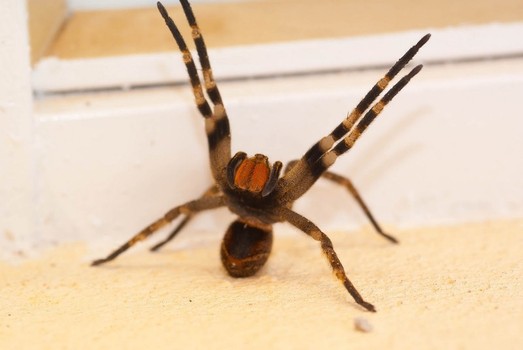A lot of people are scared of spiders, and this blog’s main mission is to demystify them and show just how wonderful they can be. So far we’ve seen an example of a cute harmless spider and an interesting spider, but it would be irresponsible to pretend that there aren’t spiders which at least partly deserve their bad reputation.
Let’s talk about the Brazilian wandering spider.

Quick Spider Facts
The name ‘Brazilian wandering spider’ refers to the Phoneutria genus, of which there are eight species.
They live in tropical areas of South and Central America.
These are medium-sized to fairly large spiders, having a body size between 15 and 48 mm depending on species and sex.
They are some of the most dangerous spiders in the world, for reasons discussed later, but an effective antivenom exists and this has reduced the number of deaths in recent years.
The Brazilian wandering spider is often referred to as the banana spider, due to its habit of stowing away in banana shipments. However, there are also many other spiders that share that common name, the main ones being the golden orb weavers of the Nephila genus, which are completely harmless (and will be covered in a future installment of the Friday Spider) and yet are often mistaken for the deadly Brazilian spider. This is an obvious area where more public knowledge about spiders would be a great thing for both spiders and people, to reduce these kinds of mix-ups!

There are several reasons why the Brazilian wanderers are so dangerous. Firstly, as their name implies, they are active, nomadic hunters, which often brings them into close proximity with people. Secondly, their venom is a highly potent and painful neurotoxin, although as mentioned there is now an effective medical treatment. (As an aside, their venom has been known to cause priapism and is being investigated as a potential treatment for erectile dysfunction.) However, compared to other spiders, Phoneutria deliver a very low percentage of envenoming bites. Venom is very energy intensive to make, and the spider would prefer not to waste it on a non-prey animal, and so it tends to deliver ‘dry’ bites as warnings to creatures much larger than themselves.
Finally, Phoneutria are considered to be very aggressive spiders. Now, this does not mean they intentionally seek conflict – this would be quite stupid of them! – but it does mean that they are more likely to confront a threat than to run away, unlike the vast majority of spider species. They have a tell-tale threat display, shown up the page, which they use to warn off any large creatures they feel intimidated by. If you see a spider posing like this, it wants you to go away. You should probably do that!
Despite all of these dangers, I don’t dislike this spider. I have a lot of respect for it. It’s very good at being a spider! I would just prefer to show that respect from a distance, and I think the spider would prefer that too.
tldr LEAVE SPIDER ALONE D: